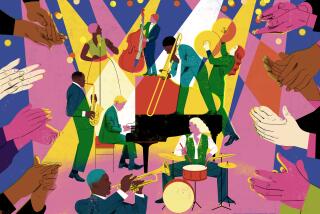JAZZ REVIEW : Sabella Consort Performs Chamber Jazz in Costa Mesa : The concert at Orange Coast College blends electric and acoustic as well as earthy and ethereal sounds.
- Share via
COSTA MESA — Add the Sabella Consort to the growing list of ensembles playing chamber jazz, Gunter Schuller’s term for the mix of classical forms and jazz sensibilities.
Led by guitarist Rusty Sabella, the trio’s performance Saturday at the Fine Arts Recital Hall on the Orange Coast College campus blended electric and acoustic as well as earthy and ethereal sounds in a style pioneered by groups like Oregon and the Paul Winter Consort.
Though it dubs its pastoral, percussion-lite music “renaissance jazz,” the Consort’s genre-jumping hybrid has little to do with the music of the Renaissance. The numbers are more folk than classically oriented, with Irish reels setting a rhythmic stage for saxophone and keyboard improvisations, or blues changes being given the structural dignity of a minuet. Sabella’s originals don’t depend on repetition as do the New Music compositions of, say, Philip Glass, and are too involved rhythmically and harmonically to be dismissed as New Age. Dance rhythms are at the heart of this fusion.
The trio--with saxophonist Jim Coile and keyboardist John Alberts--gets a sound larger than their numbers thanks in part to modern technology. But despite the use of electronics, the Consort’s music comes off especially clean and natural, due in large measure to Sabella’s crisp guitar work and crystalline amplification.
Even when Coile played the electronic wind instrument (EWI), a kind of saxophone-synthesizer, his tone recalled the lightness of pan pipes or the gentle majesty of recorders. Alberts provided bass lines from the left side of his keyboard and Coile offered occasional percussion support by shaking a can holding popcorn kernels. The total effect seemed to cut across both time and space.
The group opened with a snappy melody played in unison by guitar and flute that was propelled by little more than the tapping of Sabella’s bright blue shoe on the stage. “Eskimo Dancers,” a number inspired by a visit to Alaska, worked a cool dance figure that the guitarist, avoiding histrionics, graced with melodic, purely pitched lines and well-placed chording. Coile’s piccolo-like EWI tones added warmth to the reserved piece.
Sabella turned to mandolin for a reading of the “Tarantella,” a 19th-Century Italian dance form with whirling, feverish tempos that were said to cure the poisonous bite of a tarantula. As the piece accelerated, Coile’s flute shadowed Sabella’s bright mandolin phrases as Alberts added a synthesized vocal effect.
The nicely circular construction of “Sleepwalker’s Samba” centered on dream-like atmospherics the trio created from EWI echoes, scattered guitar chords and keyboard twinkles. The best-received pieces were those based on Irish jigs and Scottish airs that developed from familiar themes into what Sabella described as “folk perversions.”
Despite infrequent moments when rhythms seemed to clash rather than mesh, the Consort’s musical marriage seems sound. But a better label (how about “Irish folk funk?”) seems in order.
More to Read
The biggest entertainment stories
Get our big stories about Hollywood, film, television, music, arts, culture and more right in your inbox as soon as they publish.
You may occasionally receive promotional content from the Los Angeles Times.










